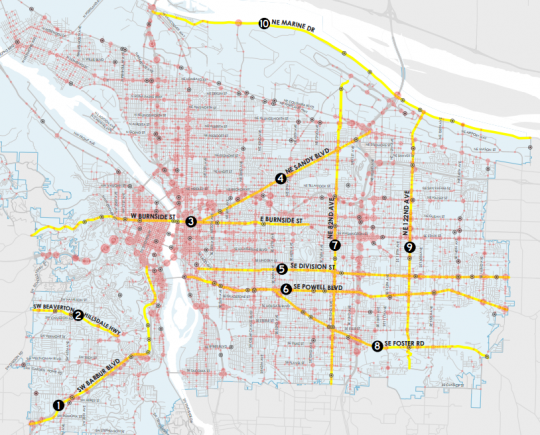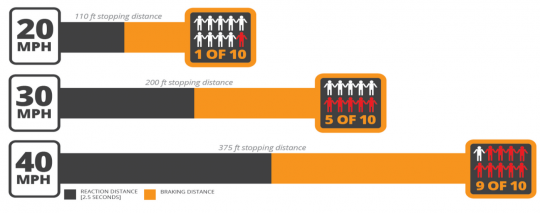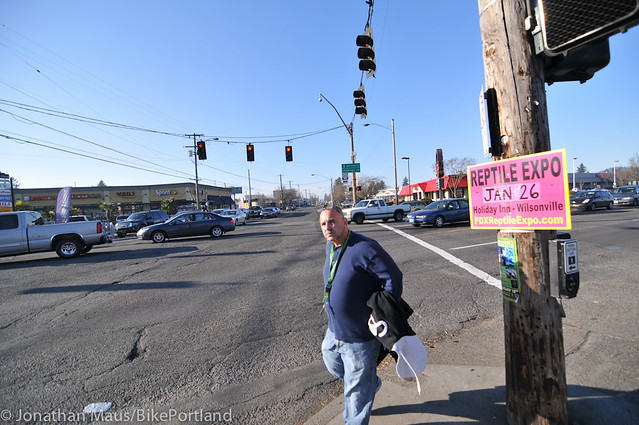
(Image: City of Portland)
As Portlanders continue to look for ways to change the culture of speed-oriented streets like Powell Boulevard, state legislators are nearing a vote on a bill designed to do exactly that.
As we reported back in March, House Bill 2621 would allow the City of Portland to install 20 automated, highly visible photo-radar cameras along its ten most dangerous streets, including Powell Boulevard.
In an email to safety advocates Monday evening, Portland Bureau of Transportation Operations and Safety Manager Gabe Graff wrote that “we’re hopeful” that the bill “will be headed to the floors of the Senate and House in a matter of weeks.”
The safety-camera bill is one of the city’s legislative priorities for the current legislative session. It’s also been endorsed by The Oregonian’s editorial board and is sponsored by state Reps. Jeff Reardon (D-Happy Valley), Chris Gorsek (D-Troutdale) and John Lively (D-Springfield).
The bill is currently before the House Ways and Means committee, but with possible floor votes nearing, the city is tentatively planning to urge supporters of the anti-speeding cameras to call or email their legislators in both the state House and Senate.
“Our 10 high-crash corridors are just 3 percent of Portland’s roadway system by lane-mile, and they account for 51 percent of our pedestrian fatalities,” Graff told us in March. “You look to other cities that have safer transportation systems than ours — New York, Seattle, Stockholm — they use these systems to great benefit.”
Advertisement
Some people have criticized the systems as public moneymakers. They would be. According to a state analysis of the bill, Portland would net $6.6 million over the next two years and about twice that in subsequent periods. The revenue would be earmarked for traffic safety, including enforcement, education and/or infrastructure.
According to the same state analysis, the cameras would also reduce excessive speeding by 61 percent over the next six years in the locations where they’d be placed.
Using figures from the National Highway Traffic Safety Administration that found a 20 to 25 percent drop in traffic collisions in areas where the cameras are installed, the city estimates that over the eight-year pilot period for the cameras, they would save 16 lives; prevent more than 2,000 people from being injured in traffic crashes; and save the economy $71 million in related wage and productivity losses, property damage and medical expenses.

The state projects that the program would start with two cameras in January 2016, gradually scaling up to 20 cameras around the city by July 2018. All would be prominently marked in order to attract attention, Graff said.
In Oregon, someone convicted of speeding 1 to 10 mph over the limit faces a fine of up to $110. For 11 to 20 mph, it’s $160; for 21-30 mph, $260; and for 30 mph or more, $435. Like other court-issued penalties, many are routinely reduced through plea agreements. Graff said in March that in order to ensure that people aren’t victims of equipment error, people wouldn’t receive tickets unless they’re observed driving well over the limit.
Also this week, members of the advocacy group BikeLoudPDX have announced that they’ll hold a “die-in” Wednesday in front of the Oregon Department of Transportation’s Portland-area headquarters at 123 NW Flanders St. in Old Town, in “protest of the blood that has been spilled on ODOT’s high crash corridors.” It’s scheduled to begin at 4 p.m.
“White clothing encouraged but optional,” the organizers write.


